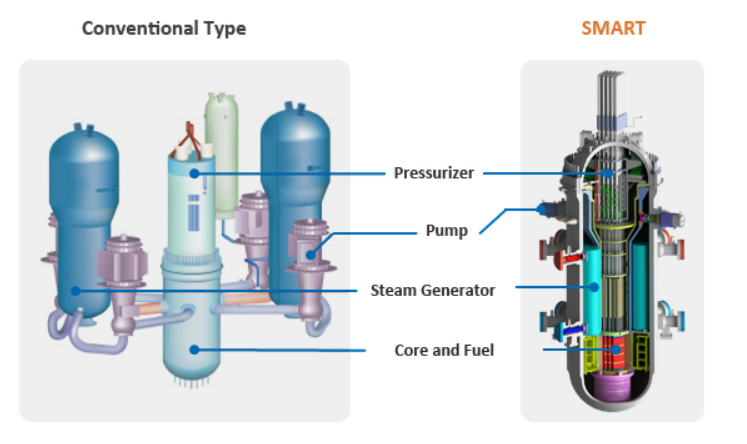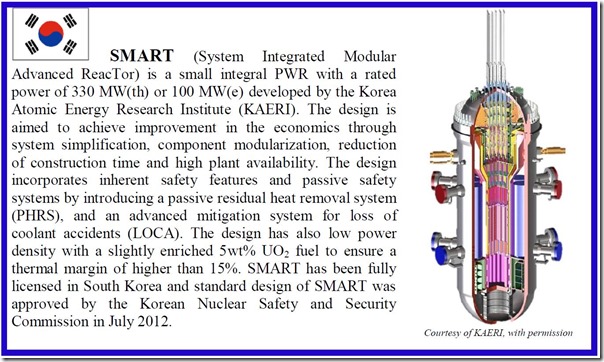·Saudi Arabia has updated its agreement with South Korea to complete a 100 MWe SMR, to license it for use in that country and to offer it for export.
·The joint project between the two countries, which began in 2011, had been stalled for several years, but is now moving forward.
·The renewed development agreement places South Korea in a pole position relative to Saudi Arabia's planned tender expected later this year for two full size nuclear reactors.
(NucNet) The government of South Korea and the King Abdullah City for Atomic and Renewable Energy in Saudi Arabia have updated their agreement to create a joint venture for the construction of a low-power small modular nuclear reactor (100 MWe).
The SMR design planned for Saudi Arabia is the Korea Atomic Research Institute’s “system-integrated modular advanced reactor” (SMART), a LWR type unit, is designed for generating electricity and for thermal applications such as seawater desalination. Scientists in South Korea have been developing the technology for 22 years. Work has been going on in Saudi Arabia with its South Korean partners since 2011.

According to South Korean sources, the plant is able to generate 100 MWe, or enough energy to supply a city with a population of 100,000 with 90 MWe of electricity and 40,000 tonnes of fresh water a day (10 MWe). The unit reportedly has a 60-year design life and three-year refuelling cycle. The LWR design uses LEU fuel at less than 5% U235.
The joint venture’s tasks are to complete the design of the reactor and non-nuclear infrastructure to support it. Additionally, the project will seek a license to build the unit in Saudia Arabia and to offer it for export. It is already licensed in South Korea.
The revised pre-project engineering contract stipulates that Korea Hydro & Nuclear Power, the operator of all nuclear power plants in South Korea, will be the EPC for the project.
According to a report by World Nuclear News, while the basic design is complete, development had been stalled by the absence of any orders for an initial reference unit. Developed by the Korea Atomic Energy Research Institute (KAERI), SMART received standard design approval from the Korean regulator in mid-2012. KAERI had planned to build a demonstration plant to operate from 2017.

In March 2015 ROK signed a deal with KSA to provide two SMART reactors in that country and to position the design for export sales. The 2015 agreement was signed by KAERI and KSA’s King Abdullah City for Atomic and Renewable Energy (KA-CARE). KA-CARE has stated it will take an equity stake in development and construction of the domestic build and marketing and sale of export units.
A three year $130 million feasibility study followed and has resulted in what could be a KSA commitment to build the first two units for a preliminary estimated cost of $1 billion. Assuming the cost of the 100 MWe units comes in at $4000/Kw, each reactor will cost $400 million with the remaining $200 million for balance of plant such as turbines, switch yard and grid improvements. Training of KSA experts to build and operate SMART reactors is part of the package.
Saudi Arabia does not have any commercial nuclear plants, but has expressed ambitions to build around 17 GW of nuclear energy over a long period of time possibly extending well past 2040. These ambitious plans were scaled back in 2015 due to a drastic drop in the price of oil from $100 bbl in September 2014 to $60 bbl the following January. Since then the price of oil has rattled around the $60 bbl line. When taking into account the number of days of production a year over at least two decades needed to pay for a fleet of reactors, the plans became unsustainable at this price.
Saudi Arabia plans to issue a tender in 2020 to construct its just two commercial nuclear power reactors and is discussing the project with U.S. and four other potential suppliers. In January 2019 Saudi Arabia said it had received expressions of interest from five countries to build the first two plants. It said the countries were Russia, China, the US, France and South Korea.
The world’s top oil exporter wants to diversify its energy mix, adding nuclear power so it can free up more crude for export. But the plans are facing scrutiny in the U.S. because of potential dual uses for the technology. Saudi Arabia would need a 123 Agreement for U.S. firms to export nuclear technologies to Saudi Arabia.
South Korea's 123 Agreement with the U.S. would also come into play as some of the technologies in its 1400 MWe PWR, recently certified by the NRC, contain U.S. sourced elements and licensed intellectual property. South Korea cannot act as a vendor with the 1400 PWR selling it to another country that does not also have a 123 agreement in place with the U.S.
South Korea is already building the Middle East’s first commercial power reactors at the Barakah nuclear station in the United Arab Emirates. There are four South Korean APR1400 units under construction at Barakah. The UAE has a 123 agreement with the U.S. which is considered to be a "gold standard" because it bans uranium enrichment and reprocessing of spent nuclear fuel. So far Saudi Arabia has declined to accept these terms for a 123 agreement with the U.S.
History of the SMART Reactor Project
The 300 MWt / 100 MWe small modular reactor (KEPCO technical briefing PDF file) is the product a consortium of 12 ROK companies which initially put up $83 million starting in June 2010 to design the reactor.
The 12 firms making the investment have a 51% equity stake in the project. Additional partners are the Posco Group with a 28% equity share and other companies having smaller equity positions include Daewoo, STX Heavy Industry, and Iljin Energy. Since 2010 over $300 million has been invested in development of the SMART reactor.
The consortium is led by the Korea Electric Power Co. (Kepco) and the design work was done at the Korea Atomic Energy Research Institute (KAERI). SMART is an acronym for “System Integrated Modular Advanced Reactor.” (Project home page)
The SMART reactor received design approval from ROK’s nuclear safety regulatory agency in 2012. A FOAK demonstration unit will be built in South Korea.